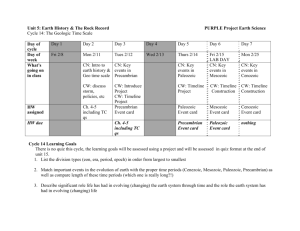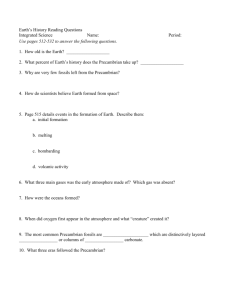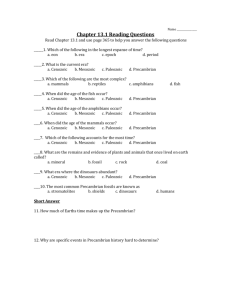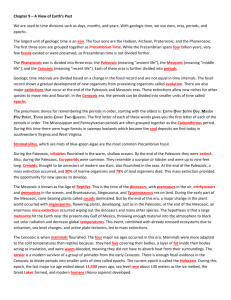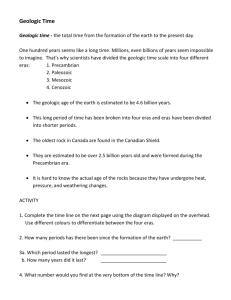Earth,Notes,RevQs,Ch22
advertisement
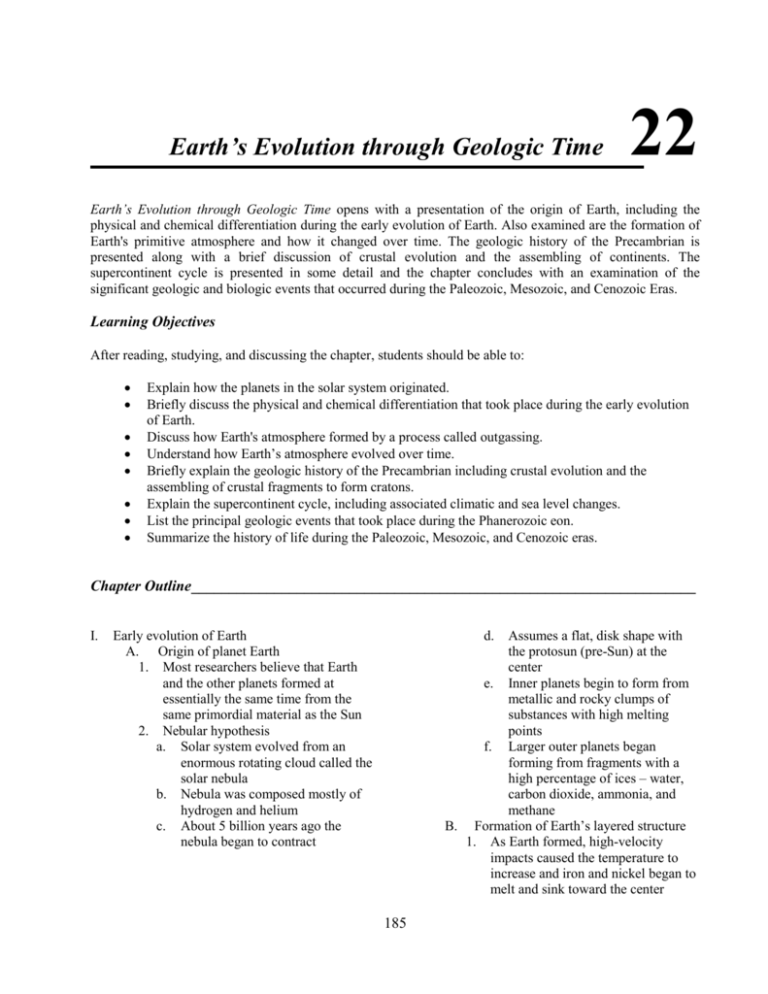
Earth’s Evolution through Geologic Time 22 Earth’s Evolution through Geologic Time opens with a presentation of the origin of Earth, including the physical and chemical differentiation during the early evolution of Earth. Also examined are the formation of Earth's primitive atmosphere and how it changed over time. The geologic history of the Precambrian is presented along with a brief discussion of crustal evolution and the assembling of continents. The supercontinent cycle is presented in some detail and the chapter concludes with an examination of the significant geologic and biologic events that occurred during the Paleozoic, Mesozoic, and Cenozoic Eras. Learning Objectives After reading, studying, and discussing the chapter, students should be able to: Explain how the planets in the solar system originated. Briefly discuss the physical and chemical differentiation that took place during the early evolution of Earth. Discuss how Earth's atmosphere formed by a process called outgassing. Understand how Earth’s atmosphere evolved over time. Briefly explain the geologic history of the Precambrian including crustal evolution and the assembling of crustal fragments to form cratons. Explain the supercontinent cycle, including associated climatic and sea level changes. List the principal geologic events that took place during the Phanerozoic eon. Summarize the history of life during the Paleozoic, Mesozoic, and Cenozoic eras. Chapter Outline___________________________________________________________________ I. Early evolution of Earth A. Origin of planet Earth 1. Most researchers believe that Earth and the other planets formed at essentially the same time from the same primordial material as the Sun 2. Nebular hypothesis a. Solar system evolved from an enormous rotating cloud called the solar nebula b. Nebula was composed mostly of hydrogen and helium c. About 5 billion years ago the nebula began to contract d. Assumes a flat, disk shape with the protosun (pre-Sun) at the center e. Inner planets begin to form from metallic and rocky clumps of substances with high melting points f. Larger outer planets began forming from fragments with a high percentage of ices – water, carbon dioxide, ammonia, and methane B. Formation of Earth’s layered structure 1. As Earth formed, high-velocity impacts caused the temperature to increase and iron and nickel began to melt and sink toward the center 185 186 CHAPTER 22 2. Buoyant masses of molten rock rose to the surface to produce a primitive crust 3. Early chemical segregation established the three basis divisions of Earth’s interior a. An iron-rich core b. A thin primitive crust, and c. The mantle between the core and crust 4. A primitive atmosphere evolved as gaseous materials escaped from Earth’s interior II. Earth's atmosphere evolves A. Primitive atmosphere formed from volcanic gases 1. A process called outgassing 2. Water vapor, carbon dioxide, nitrogen, and several trace gases 3. Very little free oxygen B. Water vapor condenses and forms primitive oceans as Earth cools C. Bacteria evolve D. Plants evolve and photosynthesis produces oxygen E. Oxygen content in the atmosphere increases F. By about 4 billion years after Earth formed, abundant ocean-dwelling organisms that require oxygen existed III. Earth's history A. Precambrian era 1. 4.5 billion to 540 million years ago 2. 88 percent of Earth's history 3. Only sketchy knowledge 4. Most Precambrian rocks are devoid of fossils 5. Precambrian rocks a. Most are buried from view b. Each continent has a "core area" of Precambrian rocks called a shield c. Extensive iron ore deposits d. Absent are fossil fuels 6. Precambrian fossils a. Most common are stromatolites 1. Material deposited by algae 2. Common about 2 billion years ago b. Microfossils of bacteria and algae have been found in chert 1. Southern Africa (3.1 billion years of age) 2. Lake Superior area (1.7 billion years of age) c. Plant fossils date from the middle Precambrian d. Animal fossils date from the late Precambrian e. Diverse and multicelled organisms exist by the close of the Precambrian B. Paleozoic era 1. 540 million years ago to about 248 million years ago 2. First life forms with hard parts 3. Abundant Paleozoic fossils 4. Early Paleozoic history a. Southern continent of Gondwanaland exists b. North America 1. A barren lowland 2. Seas move inland and recede several times and shallow marine basins evaporate leaving rock salt and gypsum deposits 3. Taconic orogeny, a mountain building event, affects eastern North America 5. Early Paleozoic life a. Restricted to seas b. Vertebrates had not yet evolved c. Life consisted of several invertebrate groups 1. Trilobites 2. Brachiopods 3. Cephalopods d. First organisms with hard parts, such as shells – perhaps for protection 6. Late Paleozoic history a. Supercontinent of Pangaea forms b. Several mountain belts formed during the movements of the continents Earth’s Evolution through Geologic Time c. World's climate becomes very seasonal, causing the dramatic extinction of many species 7. Late Paleozoic life a. Organisms diversified dramatically b. Land plants c. Fishes evolve into two groups of bony fish 1. Lung fish 2. Lobe-finned fish which become the amphibians d. Insects invade the land e. Amphibians diversify rapidly f. Extensive coal swamps develop C. Mesozoic era 1. 248 million years ago to about 65 million years ago 2. Often called the "age of dinosaurs" 3. Mesozoic history a. Begins with much of the world's land above sea level b. Seas invade western North America c. Breakup of Pangaea begins forming the Atlantic ocean d. North American plate began to override the Pacific plate e. Mountains of western North America began forming 4. Mesozoic life a. Survivors of the great Paleozoic extinction b. Gymnosperms become the dominant trees c. Reptiles (first true terrestrial animals) readily adapt to the dry Mesozoic climate d. Reptiles have shell-covered eggs that can be laid on the land e. Dinosaurs dominate f. One group of reptiles led to the 187 birds g. Many reptile groups, along with many other animal groups, become extinct at the close of the Mesozoic 1. One hypothesis is that a large asteroid or comet struck Earth 2. Another possibility is extensive volcanism D. Cenozoic era 1. 65 million years ago to the present 2. Often called the "age of mammals" 3. Smaller fraction of geologic time than either the Paleozoic or the Mesozoic 4. North America a. Most of the continent was above sea level throughout the Cenozoic era b. Many events of mountain building, volcanism, and earthquakes in the West c. Eastern North America 1. Stable with abundant marine sedimentation 2. Eroded Appalachians were raised by isostatic adjustments d. Western North America 1. Building of the Rocky Mountains was coming to an end 2. Large region is uplifted a. Basin and Range Province formed b. Re-elevates the Rockies c. Rivers erode and form gorges (e.g., Grand Canyon and Black Canyon d. Volcanic activity is common 1. Fissure eruptions form the Columbia Plateau 2. Volcanoes form from northern California to the Canadian border e. 188 Coast Ranges form CHAPTER 22 f. Sierra Nevada become fault-block mountains 5. Cenozoic life a. Mammals replace reptiles as the dominant land animals b. Angiosperms (flowering plants with covered seeds) dominate the plant world 1. Strongly influenced the evolution of both birds and mammals 2. Food source for both birds and mammals c. Two groups of mammals evolve after the reptilian extinctions at the close of the Mesozoic 1. Marsupials 2. Placentals d. Mammals diversify quite rapidly and some groups become very large 1. e.g., Hornless rhinoceros, which stood nearly 16 feet high 2. Many large animals became extinct e. Humans evolve Answers to the Review Questions 1. The metallic core of Earth is important to humans today because it supports our magnetic field, which prevents cosmic rays (solar winds) from reaching the surface. 2. Hydrogen and helium most likely made up much of the early universe. 3. Supernova. 4. The theory for the origin of the solar system, called the nebular hypothesis, states that approximately 5 billion years ago the bodies of the solar system condensed from an enormous cloud. As the cloud contracted and began to rotate, the protosun began forming. The protoplanets (planets in the making) formed from material that had condensed and accreted inside the cloud. The inner planets, Mercury, Venus, Earth, and Mars were unable to retain appreciable amounts of the lighter components of the primordial cloud; while the outer planets (Jupiter, Saturn, Uranus, and Neptune) accumulated large amounts of hydrogen and other light materials because of their much colder temperatures. 5. Outgassing refers to the process by which Earth’s early atmosphere was formed by gases, trapped in the planet’s interior, erupted from volcanoes over millions of years. Outgassing continues today from hundreds of active volcanoes worldwide. 6. Earth’s early atmosphere was composed mainly of water vapor and carbon dioxide. 7. The free oxygen in Earth's atmosphere today originated from green plants releasing oxygen during the process of photosynthesis. 8. Water in the first oceans came from the water vapor erupted from volcanoes via outgassing. Earth’s Evolution through Geologic Time 189 9. Carbon dioxide is highly soluble in water and it is removed from our atmosphere by the precipitation of calcium carbonate to form the chemical sedimentary rock, limestone. Marine organisms, such as foraminifera, remove calcium carbonate from seawater to make their shells and other hard parts. 10. Precambrian history is more difficult to decipher because of the lack of fossils, which hinders correlation of rocks. Also, rocks of this great age are metamorphosed and deformed, extensively eroded, and obscured by younger overlying strata. 11. Cratons are thoughts to form from the collision and accretion of various types of terranes. Such collisional tectonics deforms and metamorphoses the sediments caught between the converging crustal fragments, which shortens and thickens the developing crust. Partial melting in the deepest regions of these collision zones generates silica-rich magmas that intrude the crustal rocks above. 12. Supercontinents are large landmasses that contain all, or nearly all, of the existing continents on Earth at any given time. The supercontinent cycle is the idea that rifting and dispersal of one supercontinent is followed by a long period during which the fragments are gradually reassembled into a new supercontinent having a different configuration. 13. The movement of continents can produce global climate change because they change the patterns of ocean currents and global wind patterns. As a result of such changes, the distribution of temperatures and precipitation worldwide changed as well. 14. (a) Paleozoic; (b) Precambrian; (c) Cenozoic; (d) Precambrian; (e) Mesozoic; (f) Cenozoic; (g) Paleozoic; (h) Paleozoic; (i) Mesozoic; (j) Precambrian; (k) Mesozoic; (l) Paleozoic; (m) Paleozoic; (n) Cenozoic; (o) Paleozoic; (p) Mesozoic; (q) Precambrian; (r) Cenozoic 15. During the Cenozoic the eastern continental margin of North America was tectonically stable and the site of abundant marine sedimentation. The western margin, on the other hand, was the leading edge of the North American plate. As a result, plate interactions during the Cenozoic gave rise to many events of mountain building, volcanism, and earthquakes in the West. 16. In order to move onto the land from the oceans plants had to develop a mechanism for obtaining water and also a structure that allowed them to stay upright, despite gravity and wind. 17. The lobe-finned fish are thought to have developed the ability to stay out of water for longer periods of time and eventually became the first amphibians. 18. Amphibians are not considered to be true land animals because they are born in the water and originally they have gills and tails. Over time these features disappear as the amphibians become air-breathing organisms with legs. 19. Unlike amphibians, reptiles have shell-covered eggs that can be laid on land. The appearance of shellcovered eggs in the Mesozoic eliminated a water-dwelling stage and it was an important evolutionary step in the development of reptiles. 190 CHAPTER 22 Lecture outline, art-only, and animation PowerPoint presentations for each chapter of Earth, 9e are available on the Instructor’s Resource Center CD (0131566911).
